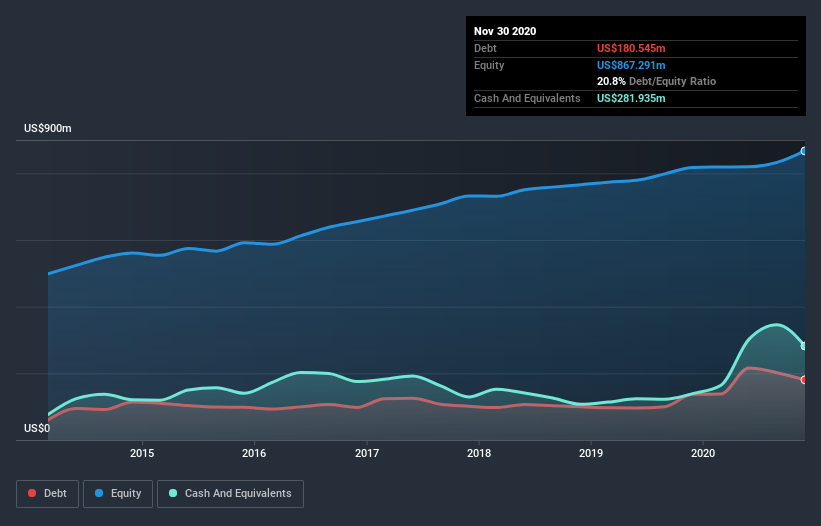PriceSmart (NASDAQ:PSMT) Has A Pretty Healthy Balance Sheet
Some say volatility, rather than debt, is the best way to think about risk as an investor, but Warren Buffett famously said that 'Volatility is far from synonymous with risk.' So it might be obvious that you need to consider debt, when you think about how risky any given stock is, because too much debt can sink a company. As with many other companies PriceSmart, Inc. (NASDAQ:PSMT) makes use of debt. But the more important question is: how much risk is that debt creating?
Why Does Debt Bring Risk?
Debt assists a business until the business has trouble paying it off, either with new capital or with free cash flow. Ultimately, if the company can't fulfill its legal obligations to repay debt, shareholders could walk away with nothing. However, a more frequent (but still costly) occurrence is where a company must issue shares at bargain-basement prices, permanently diluting shareholders, just to shore up its balance sheet. Of course, debt can be an important tool in businesses, particularly capital heavy businesses. When we examine debt levels, we first consider both cash and debt levels, together.
See our latest analysis for PriceSmart
How Much Debt Does PriceSmart Carry?
You can click the graphic below for the historical numbers, but it shows that as of November 2020 PriceSmart had US$180.5m of debt, an increase on US$136.9m, over one year. However, its balance sheet shows it holds US$281.9m in cash, so it actually has US$101.4m net cash.
A Look At PriceSmart's Liabilities
According to the last reported balance sheet, PriceSmart had liabilities of US$558.4m due within 12 months, and liabilities of US$252.3m due beyond 12 months. On the other hand, it had cash of US$281.9m and US$30.8m worth of receivables due within a year. So its liabilities outweigh the sum of its cash and (near-term) receivables by US$497.9m.
Given PriceSmart has a market capitalization of US$3.09b, it's hard to believe these liabilities pose much threat. But there are sufficient liabilities that we would certainly recommend shareholders continue to monitor the balance sheet, going forward. Despite its noteworthy liabilities, PriceSmart boasts net cash, so it's fair to say it does not have a heavy debt load!
Also good is that PriceSmart grew its EBIT at 15% over the last year, further increasing its ability to manage debt. The balance sheet is clearly the area to focus on when you are analysing debt. But it is future earnings, more than anything, that will determine PriceSmart's ability to maintain a healthy balance sheet going forward. So if you want to see what the professionals think, you might find this free report on analyst profit forecasts to be interesting.
Finally, a business needs free cash flow to pay off debt; accounting profits just don't cut it. PriceSmart may have net cash on the balance sheet, but it is still interesting to look at how well the business converts its earnings before interest and tax (EBIT) to free cash flow, because that will influence both its need for, and its capacity to manage debt. Over the most recent three years, PriceSmart recorded free cash flow worth 53% of its EBIT, which is around normal, given free cash flow excludes interest and tax. This free cash flow puts the company in a good position to pay down debt, when appropriate.
Summing up
Although PriceSmart's balance sheet isn't particularly strong, due to the total liabilities, it is clearly positive to see that it has net cash of US$101.4m. And it also grew its EBIT by 15% over the last year. So we don't think PriceSmart's use of debt is risky. When analysing debt levels, the balance sheet is the obvious place to start. However, not all investment risk resides within the balance sheet - far from it. For example, we've discovered 2 warning signs for PriceSmart that you should be aware of before investing here.
If you're interested in investing in businesses that can grow profits without the burden of debt, then check out this free list of growing businesses that have net cash on the balance sheet.
This article by Simply Wall St is general in nature. It does not constitute a recommendation to buy or sell any stock, and does not take account of your objectives, or your financial situation. We aim to bring you long-term focused analysis driven by fundamental data. Note that our analysis may not factor in the latest price-sensitive company announcements or qualitative material. Simply Wall St has no position in any stocks mentioned.
Have feedback on this article? Concerned about the content? Get in touch with us directly. Alternatively, email editorial-team (at) simplywallst.com.

 Yahoo Finance
Yahoo Finance 
